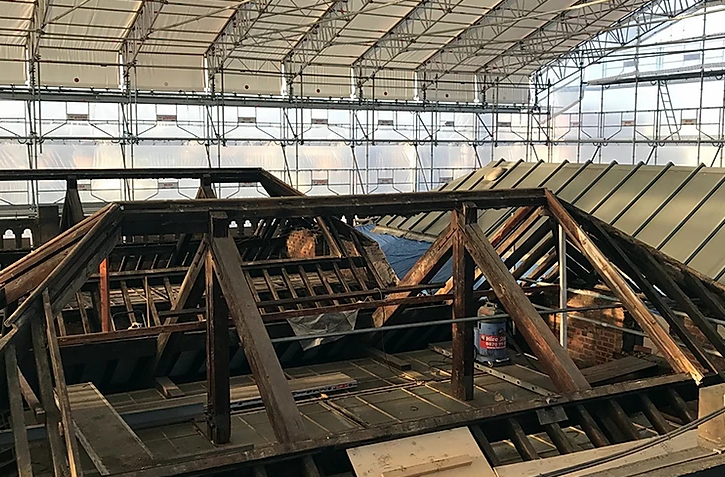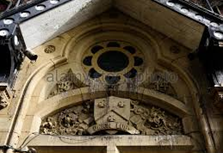Heritage Roofing
Heritage roofing - maintaining our iconic buildings
The UK is home to some of the most iconic buildings in the world, from stunning churches and cathedrals to historic stately homes. Each and every one of these remarkable feats of architecture requires regular maintenance to ensure they remain in the very best condition, allowing them to be enjoyed for generations.
Cathedral Care
Restoration and upkeep of cathedrals
There are some 42 Anglican cathedrals in the UK, not to mention 20 or so Catholic cathedrals. Cathedrals form the most important collection of historic buildings in England. The largest and most ancient are internationally famous, the smallest are usually among the most significant buildings in their region and even the most recent are architectural masterpieces.
Master Craftsmen
Championing our heritage with modern craftsmanship
Twenty years ago, English Heritage (now Historic England) published its first-ever Register of Buildings at Risk across England, which featured nearly 2,000 buildings and monuments that were ‘neglected, broken and unloved’. Recently Historic England was delighted to announce that over two-thirds of those buildings were now safe, in both urban and rural areas right across the country.
Lightning Protection
When lightning strikes are you protected against this act of God?
The issue of lightning protection in churches is one that has exercised this publication for many years. In this four-part series of spotlights on the issue we will be revisiting various aspects of the subject, beginning with an overview of current thinking.
Traditional Lime
Lime: it’s better for buildings – and for the environment
It is now fairly well known that cement is not good for old buildings and that lime mortar should be used. But why? What are the advantages and what are the disadvantages? In order to begin to answer those questions it is necessary to understand the nature of traditional building, the process by which buildings used to be built, and how it differs from modern construction, the process by which we build today.
Audio Visual
Audio visual equipment in church buildings
This guidance is issued by the Church Buildings Council under section 55(1)(d) of the Dioceses, Mission and Pastoral Measure 2007. As it is statutory guidance, it must be considered with great care. The standards of good practice set out in the guidance should not be departed from unless the departure is justified by reasons that are spelled out clearly, logically and convincingly.
Read More...
CRE Events
All change at CRE: the UK’s ‘ideal church show’
The Christian Resources Exhibition (CRE), the UK’s largest church-related show, has changed hands in its 40th year and has been taken over by Quartz Business Media.
Insurance
You need to ensure that reasonable precautions are in place at your church to keep it safe for those who use it. To do this, you need to think about what might cause harm to people.
You will then need to decide if the precautions already in place are adequate. If they are not, you may need to identify further action to prevent any danger. When done formally, this is known as a risk assessment.
LPOW Grants
£23 million government package to support restoration of thousands of listed places of worship
Heritage Minister Sir Chris Bryant has announced that the Listed Places of Worship Grant Scheme will be extended into the next financial year, providing £23 million so that thousands of historical buildings, including churches, synagogues, mosques and temples, can carry out restoration work.
Church Maintenance
Church maintenance and repair: Calendar of Care
Just as prevention is always better than cure, maintenance is preferable to major repairs. But, such repairs may not always be avoidable. Church Care offers a monthly guide in our coming issues Starting in Spring
We can help you understand the common problems and areas that need your special attention, and give you tips for regular maintenance schemes.
Pest Control
Michael Palin warns of pest threat to churches
Michael Palin is supporting the future of the UK’s historic churches and chapels with a voiceover for a new animated film. The 80 second animation, produced for the National Churches Trust, highlights why churches are some of the nation’s best loved buildings.
Town Halls
The history of the great Victorian Town Halls of Northern England
From industrial squalor to civic pride, the story behind some of the most impressive buildings of the North involve a unique mix of economics, grand designs and noble sentiments within communities.
Lead Roofing
Lead is one of the oldest materials in the roofing industry and is still commonly used throughout the world today.
Lead roofing is a traditional roofing method which has been used in the industry for hundreds of years, and is therefore proven to be extremely reliable. Lead roofing, and sand-cast lead, in particular is ideal for old buildings such as churches or historical renovations, whereas milled lead roofing is a mass-produced alternative, used for precision and accuracy in homes and commercial buildings alike.
SEARCH OUR DIRECTORY
Copper in restoration
Facts About Copper
Copper was one of the first metals to be exploited by man over 10,000 years ago. The Romans used it as a roof covering for the Pantheon in 27 BC and many of the great churchs of medieval Europe were roofed in the material. Indeed, the Copper roof of Hildersheim Cathedral installed in 1280 survives intact to this day.
1. Long Life. Copper can be traced back for use in roofing and guttering to 27bc when the roof of the pantheon in Rome was covered in Copper. It is a pure, natural material with the added attraction of unique changing visual characteristics. Offering and effectively indefinite design life, it is extremely durable and resistant to corrosion in any atmosphere, requiring no decoration, cleaning and virtually no maintenance other than the removal of debris that may fall into the guttering. Copper is environmentally friendly, fully recyclable, safe to use and can be worked at all temperatures.
2. Environmental Implications. Copper is a wholly natural material present in and essential to all plants, animals and humans. Unlike other metals such as Lead, Copper is non-toxic and does not accumulate in the body.
3. Low Maintenance. Besides its high corrosion resistance and attractive appearance it also acts as an algaecide and fungicide, keeping growths suvh as moss and lichens to a minimum. This is important as these growths can cause blockages and additional maintenance in all other types of gutter systems. Tried and tested fixing details and techniques make Copper the most trouble-free material for roofing, cladding, flashing, gutters and down pipes.
4. Sustainability. Copper is one of the few metals that is fully sustainable. On average 40% of all production is from recycled metal. We are in no danger of running out of Copper and to date only 12% of the current known reserves have been mined. 90% of Copper scrap is reused and approximately 55% of Copper used in Architecture comes from recycling.
5. Durability. When Copper is exposed to the elements, it protects itself by delevoping a Patina over time which reforms if damaged, ensuring durability and resistance to corrosion in virtually any atmosphere. Unlike other materials Copper does not suffer from under-side corrosion.
6. CDM Regulations, Health & Safety. Copper is non-toxic and presents no risks associated with long term contact. Health monitoring for workers using other metals such as Lead does not apply to Copper workers.
7. Patina. When initially exposed to the atmosphere, a Copper oxide film forms changing the colour from a Salmon Pink to a Russet Brown. As weathering progresses over the years, cupreous and cupric sulphide films convert to the basic Copper suphate Patina, which gives Copper the distinctive "aged" light green colour. Depending on the atmospheric conditions this Patination process can take 5 years in a severe marine environment to 50 years in a dry country location.
8. Embodied Energy / Carbon Dioxide Emissions. The embodied energy of Copper is 50mj/sq m compared to Aluminium of 100+mj/sq m. The carbon dioxide emissions for Copper are 2kg/sq m compared to Aluminium of 5.2kg/sq m.
9. Cost Comparisons. Over the life cycle of a building Copper generally is one of the most competitive building materials available.
10. Expansion and Contraction. Copper has a low thermal co-efficient of expansion (0.0168mm/m/deg c) being approximately 40% less than Zinc and Lead. This means that Copper guttering can be fitted without the need for expansion joints on continuous straight runs of less than 100 metres. When guttering is secured to the Copper brackets, the ductility and malleability is so good that slight movements due to thermal expansion and contraction are easily accommodated and do not cause problems such as buckling or cracking that can occur with other types of guttering material.
11. Compatibility. Copper gutter can be used for rainwater run-off from fresh or old concrete. It can not be used on flat bitumen sealed roofs where ponding can cause high concentrations of acid build-up. If fitting Copper to another bare metal such as Galvanised Steel insulation tape or washers should be used.
12. The Future. With growing awarness of environmental issues and increasing concern for the Health and Safety of those constructing and maintaining buildings, Copper is more than ever the most cost effective, adaptable roofing and guttering material of the future.
A beautiful Copper Ridge to enhance your property.

Thats the good thing with Copper, you can do so much with it...even window ledge's....


This is a window above a cellar to allow for more light...A Copper window frame...

These photos of the Copper roofs and guttering were unfortunately taken whilst still in the construction stage as you can see, but they are still pretty good pictures.
From Ian Cox Roofing mailto:This email address is being protected from spambots. You need JavaScript enabled to view it. Or phone us on:- 07970 457830



































